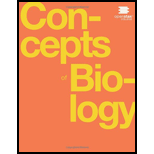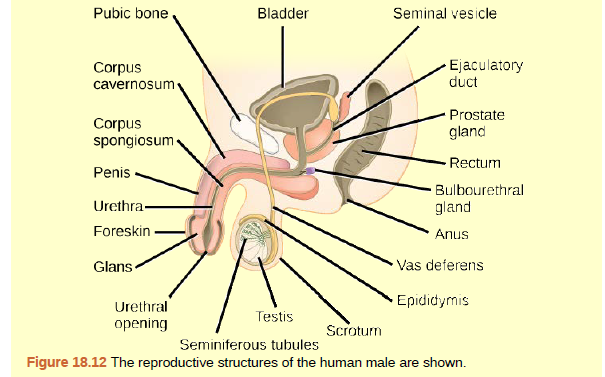
Figure 18.12 Which of the following statements about the male reproductive system is false?
a. The vas deferens carries sperm from the testes to the seminal vesicles.
b. The ejaculatory duct joins the urethra.
c. Both the prostate and the bulbourethral glands produce components of the semen.
d. The prostate gland is located in the testes.

Introduction:
The male reproductive system of the humans is a group of inter associated organs, which help in the formation of the gametes and their proper delivery out of the body. The male reproductive system also produces many hormones and other secretion important in reproduction and maintenance of the secondary sexual characteristics.
Answer to Problem 1ACQ
The correct answer is option (d).
Explanation of Solution
Explanation for the correct answer:
Option (d) prostate is located in testes. The prostate is a gland that is present between the bladder and the penis. It is a walnut-sized gland, which is situated just above the rectum. The urethra runs through the center of this gland. So, the prostate is located in testes is an incorrect answer. Hence, the correct answer is option (d).
Explanation for the incorrect answer:
Option (a) vas deferens carries the sperm to the seminal vesicles. The vas deferens carries the sperm from the testes to the seminal vesicles. From the seminal vesicles, the sperm is transferred to the ejaculatory duct. So, the vas deference carries the sperm to seminal vesicles is a correct statement. Hence, it is an incorrect answer.
Option (b) the ejaculatory duct joins the urethra. The pathway of the semen ejaculation and urine passage is the same. The ejaculatory duct joins the urethra, and share the same passage. Hence, it is an incorrect answer.
Option (c) both bulbourethral gland and prostate gland constitute the component of semen. The sperm is carried to the seminal vesicles and from there it is transferred to the ejaculatory duct. In the ejaculatory duct, the secretion of the prostate gland is added and down in the path, the secretion from the bulbourethral gland is added. So, the semen has the secretion of the bulbourethral gland and the prostate gland. Hence, it is an incorrect answer.
The prostate gland is not a part of testes. Hence, the option (d) is the correct answer.
Want to see more full solutions like this?
Chapter 18 Solutions
Concepts of Biology
Additional Science Textbook Solutions
Microbiology: An Introduction
Campbell Biology: Concepts & Connections (9th Edition)
Human Anatomy & Physiology (2nd Edition)
Campbell Biology (11th Edition)
Concepts of Genetics (12th Edition)
Campbell Essential Biology (7th Edition)
- Ch.21 What causes patients infected with the yellow fever virus to turn yellow (jaundice)? A. low blood pressure and anemia B. excess leukocytes C. alteration of skin pigments D. liver damage in final stage of disease — What is the advantage for malarial parasites to grow and replicate in red blood cells? A. able to spread quickly B. able to avoid immune detection C. low oxygen environment for growth D. cooler area of the body for growth — Which microbe does not live part of its lifecycle outside humans? A. Toxoplasma gondii B. Cytomegalovirus C. Francisella tularensis D. Plasmodium falciparum — explain your answer thoroughlyarrow_forwardCh.22 Streptococcus pneumoniae has a capsule to protect it from killing by alveolar macrophages, which kill bacteria by… A. cytokines B. antibodies C. complement D. phagocytosis — What fact about the influenza virus allows the dramatic antigenic shift that generates novel strains? A. very large size B. enveloped C. segmented genome D. over 100 genes — explain your answer thoroughlyarrow_forwardWhat is this?arrow_forward
- Molecular Biology A-C components of the question are corresponding to attached image labeled 1. D component of the question is corresponding to attached image labeled 2. For a eukaryotic mRNA, the sequences is as follows where AUGrepresents the start codon, the yellow is the Kozak sequence and (XXX) just represents any codonfor an amino acid (no stop codons here). G-cap and polyA tail are not shown A. How long is the peptide produced?B. What is the function (a sentence) of the UAA highlighted in blue?C. If the sequence highlighted in blue were changed from UAA to UAG, how would that affecttranslation? D. (1) The sequence highlighted in yellow above is moved to a new position indicated below. Howwould that affect translation? (2) How long would be the protein produced from this new mRNA? Thank youarrow_forwardMolecular Biology Question Explain why the cell doesn’t need 61 tRNAs (one for each codon). Please help. Thank youarrow_forwardMolecular Biology You discover a disease causing mutation (indicated by the arrow) that alters splicing of its mRNA. This mutation (a base substitution in the splicing sequence) eliminates a 3’ splice site resulting in the inclusion of the second intron (I2) in the final mRNA. We are going to pretend that this intron is short having only 15 nucleotides (most introns are much longer so this is just to make things simple) with the following sequence shown below in bold. The ( ) indicate the reading frames in the exons; the included intron 2 sequences are in bold. A. Would you expected this change to be harmful? ExplainB. If you were to do gene therapy to fix this problem, briefly explain what type of gene therapy youwould use to correct this. Please help. Thank youarrow_forward
- Molecular Biology Question Please help. Thank you Explain what is meant by the term “defective virus.” Explain how a defective virus is able to replicate.arrow_forwardMolecular Biology Explain why changing the codon GGG to GGA should not be harmful. Please help . Thank youarrow_forwardStage Percent Time in Hours Interphase .60 14.4 Prophase .20 4.8 Metaphase .10 2.4 Anaphase .06 1.44 Telophase .03 .72 Cytukinesis .01 .24 Can you summarize the results in the chart and explain which phases are faster and why the slower ones are slow?arrow_forward
- Can you circle a cell in the different stages of mitosis? 1.prophase 2.metaphase 3.anaphase 4.telophase 5.cytokinesisarrow_forwardWhich microbe does not live part of its lifecycle outside humans? A. Toxoplasma gondii B. Cytomegalovirus C. Francisella tularensis D. Plasmodium falciparum explain your answer thoroughly.arrow_forwardSelect all of the following that the ablation (knockout) or ectopoic expression (gain of function) of Hox can contribute to. Another set of wings in the fruit fly, duplication of fingernails, ectopic ears in mice, excess feathers in duck/quail chimeras, and homeosis of segment 2 to jaw in Hox2a mutantsarrow_forward
 Concepts of BiologyBiologyISBN:9781938168116Author:Samantha Fowler, Rebecca Roush, James WisePublisher:OpenStax College
Concepts of BiologyBiologyISBN:9781938168116Author:Samantha Fowler, Rebecca Roush, James WisePublisher:OpenStax College Human Biology (MindTap Course List)BiologyISBN:9781305112100Author:Cecie Starr, Beverly McMillanPublisher:Cengage Learning
Human Biology (MindTap Course List)BiologyISBN:9781305112100Author:Cecie Starr, Beverly McMillanPublisher:Cengage Learning Essentials of Pharmacology for Health ProfessionsNursingISBN:9781305441620Author:WOODROWPublisher:Cengage
Essentials of Pharmacology for Health ProfessionsNursingISBN:9781305441620Author:WOODROWPublisher:Cengage





